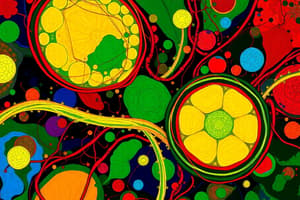Podcast
Questions and Answers
What type of cells contain chloroplasts?
What type of cells contain chloroplasts?
Plant and some algae
What is the energy plants use to make their own food?
What is the energy plants use to make their own food?
Light
The food making process is called __________.
The food making process is called __________.
Photosynthesis
What are the raw materials for photosynthesis?
What are the raw materials for photosynthesis?
What simple sugar is produced?
What simple sugar is produced?
What gas is USED? __________ RELEASED? __________
What gas is USED? __________ RELEASED? __________
Where are most photosynthetic cells in plants found?
Where are most photosynthetic cells in plants found?
About how many chloroplasts can be found in photosynthetic cells?
About how many chloroplasts can be found in photosynthetic cells?
How many membranes surround a chloroplast?
How many membranes surround a chloroplast?
The outer membrane is __________.
The outer membrane is __________.
The INDIVIDUAL SACS formed by the inner membrane are called __________ and are arranged in __________ like pancakes.
The INDIVIDUAL SACS formed by the inner membrane are called __________ and are arranged in __________ like pancakes.
What pigment is found inside a thylakoid? What color will it be?
What pigment is found inside a thylakoid? What color will it be?
Other pigments that trap sunlight are called __________ pigments. What color are these pigments?
Other pigments that trap sunlight are called __________ pigments. What color are these pigments?
STACKS of thylakoids are called _______ (plural) or Granum (singular).
STACKS of thylakoids are called _______ (plural) or Granum (singular).
Stacks or grana are connected to each other by ________.
Stacks or grana are connected to each other by ________.
Why are mitochondria called the powerhouse of the cell?
Why are mitochondria called the powerhouse of the cell?
What cell process occurs in the mitochondria?
What cell process occurs in the mitochondria?
Why do some cells have MORE mitochondria? Give an example.
Why do some cells have MORE mitochondria? Give an example.
What simple sugar is broken down in the mitochondria?
What simple sugar is broken down in the mitochondria?
Where does the energy in glucose come from ORIGINALLY?
Where does the energy in glucose come from ORIGINALLY?
Where is the energy stored in glucose?
Where is the energy stored in glucose?
Why is cellular respiration an aerobic process?
Why is cellular respiration an aerobic process?
What energy is released when the chemical bonds of glucose are broken?
What energy is released when the chemical bonds of glucose are broken?
Name two other organelles besides the mitochondria that contain DNA and have a double membrane.
Name two other organelles besides the mitochondria that contain DNA and have a double membrane.
Describe the outer membrane of the mitochondria.
Describe the outer membrane of the mitochondria.
Why is the inner of the mitochondrial membrane folded?
Why is the inner of the mitochondrial membrane folded?
What are the folds called?
What are the folds called?
What does ATP stand for?
What does ATP stand for?
What three main things make up an ATP molecule?
What three main things make up an ATP molecule?
How many high-energy bonds does ATP contain?
How many high-energy bonds does ATP contain?
Where are these high-energy bonds found in ATP?
Where are these high-energy bonds found in ATP?
What helps weaken these bonds so energy can be released and then later help reform them?
What helps weaken these bonds so energy can be released and then later help reform them?
When ATP loses a phosphate group __________ is released for cells and a molecule of __________ forms.
When ATP loses a phosphate group __________ is released for cells and a molecule of __________ forms.
What is the energy molecule of the cell called?
What is the energy molecule of the cell called?
What macromolecule made by plants is 'burned' in the mitochondria?
What macromolecule made by plants is 'burned' in the mitochondria?
Where is chlorophyll found in the chloroplast?
Where is chlorophyll found in the chloroplast?
In which part of a plant would you expect to find the most chloroplasts and why?
In which part of a plant would you expect to find the most chloroplasts and why?
How would the number of mitochondria in an insect's wing compare to the amount found in other cells in an insect's body? Explain your answer.
How would the number of mitochondria in an insect's wing compare to the amount found in other cells in an insect's body? Explain your answer.
What are the raw materials for photosynthesis?
What are the raw materials for photosynthesis?
What product of photosynthesis is used in cellular respiration?
What product of photosynthesis is used in cellular respiration?
What is the advantage of having a folded inner membrane in the mitochondria?
What is the advantage of having a folded inner membrane in the mitochondria?
What is the energy for photosynthesis?
What is the energy for photosynthesis?
Besides chlorophyll, what other pigments are found in the chloroplasts?
Besides chlorophyll, what other pigments are found in the chloroplasts?
Flashcards are hidden until you start studying
Study Notes
Chloroplasts
- Found in plant cells and some algae, chloroplasts play a key role in photosynthesis.
- Photosynthesis is the process where plants convert light energy into chemical energy.
- Raw materials needed for photosynthesis include carbon dioxide (CO2), water (H2O), and sunlight.
- The primary product of photosynthesis is glucose, a simple sugar.
- Oxygen (O2) is released as a byproduct of photosynthesis.
Structure of Chloroplasts
- Chloroplasts contain thousands of structures called thylakoids arranged in stacks known as grana.
- Thylakoids contain chlorophyll, the pigment responsible for absorbing light, giving them a dark green color.
- Accessory pigments, which can be red, yellow, orange, or brown, help capture additional light.
- Each chloroplast is surrounded by two membranes, with the outer membrane being smooth.
- Lamellae connect thylakoid stacks (grana).
Mitochondria
- Known as the powerhouse of the cell, mitochondria convert glucose into usable energy through aerobic cellular respiration.
- More active cells, like muscle cells, contain a greater number of mitochondria due to higher energy demands.
- Mitochondria also have a double membrane with the outer membrane being smooth.
- The inner membrane is folded into structures called cristae, increasing the surface area for energy production.
Energy Conversion
- Glucose is broken down in the mitochondria to release energy stored in its chemical bonds, originally derived from sunlight.
- ATP (Adenosine Triphosphate) is the energy currency produced during cellular respiration when glucose is metabolized.
- ATP contains two high-energy bonds located in the last two phosphate groups.
- Enzymes facilitate the breaking and reformation of these phosphate bonds, releasing energy for cellular functions.
Comparisons and Functions
- Chloroplasts primarily function in photosynthesis, occurring mainly in leaves where most photosynthetic cells are located.
- Mitochondria facilitate energy production through cellular respiration, utilizing glucose produced by chloroplasts.
- The energy product of photosynthesis, glucose, is essential for cellular respiration in mitochondria.
- Accessory pigments found in chloroplasts assist in light absorption for enhanced photosynthesis efficiency.
Summary of Functions
- ATP serves as the main energy molecule for cellular processes.
- Increased surface area in both chloroplasts and mitochondria enhances their efficiency and energy production capacity.
- The interplay between chloroplasts and mitochondria is crucial for the energy cycle within plant cells.
Studying That Suits You
Use AI to generate personalized quizzes and flashcards to suit your learning preferences.




